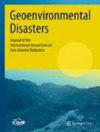印度尼西亚西爪哇 2022 年 5.6 级 Cianjur 地震引发的共震变形及相关危害:地震学分析、DInSAR 和地貌学调查的综合启示
IF 4
Q2 ENVIRONMENTAL SCIENCES
引用次数: 0
摘要
2022 年 11 月 21 日,印度尼西亚西爪哇省仙朱尔地区发生 5.6 级地震。随后,至少 512 次余震从 11 月持续到 2023 年 6 月。这次地震发生在一个以前未被确认为活跃断层带的地区。这次地震在 Cianjur 造成了严重后果,既造成了人员伤亡,也造成了广泛的结构性破坏。建筑物的严重损坏很可能是地表变形效应导致当地地形突然改变的结果。本研究旨在从空间上确定 2022 年仙居地震造成的地表变形模式及其与当地地貌环境的关系。在这项研究中,我们对 45 个地震台站进行了地震学分析,对主震和余震数据、雷达哨兵-1 图像进行了统计分析,并采用了 DInSAR 方法。此外,还进行了实地调查,以确定研究区域的地貌特征。结果显示,变形包括下沉和隆起。结果表明,在 2022 年 11 月 21 日的主震期间,Cianjur 及其周边地区出现了下沉变形,平均变形值约为-5 厘米。相比之下,余震期间测量到的变形则表现为隆起变形,平均值为 10 厘米。对 2022 年仙居地震序列中的形变模式进行的研究发现,库根南地区附近的形变值较高,方向为西北至东南。所进行的地貌调查表明,仙居地区包含多种地貌,如火山地貌、结构地貌、河流地貌和剥蚀地貌。这些地貌对地震活动的反应各不相同。在山区地形中,由于地震活动的影响,经常出现山体滑坡等共震灾害。地表变形的时空变化有多种原因,如余震的数量和分布、应力重新分布、断层相互作用、次生效应和当地地质环境。主震会沿断层释放累积的应力,导致特定类型的变形,而余震则可能重新分配相邻断层上的应力。余震引发的次生效应,加上当地的地质和地貌条件,进一步促成了地震事件期间观察到的地面变形的多样化模式。研究结果表明,地面变形对河流、火山和剥蚀过程的影响最大,导致特定区域出现明显的沉降和隆起。主震和余震都引发了同震滑坡的发生和规模,这些滑坡发生在风化的地质材料上。同时出现的雨季进一步扩大了这些影响。从这项研究中获得的知识可用于评估地震的影响,并主动降低未来的风险。本文章由计算机程序翻译,如有差异,请以英文原文为准。
Co-seismic deformation and related hazards associated with the 2022 Mw 5.6 Cianjur earthquake in West Java, Indonesia: insights from combined seismological analysis, DInSAR, and geomorphological investigations
On November 21, 2022, a magnitude Mw 5.6 earthquake struck Cianjur Regency in the West Java Province of Indonesia. It was followed by at least 512 aftershocks that persisted from November to June 2023. This seismic event occurred in an area previously unrecognized as an active fault zone. The consequences of this earthquake in Cianjur were severe, leading to both loss of life and extensive structural damage. The substantial damage to buildings was likely a result of abrupt alterations in the local topography due to surface deformation effects. This research endeavor aims to spatially determine the patterns of ground surface deformation and its relationship with local geomorphological setting due to earthquakes in Cianjur in 2022. In this study we conduct seismological analysis of 45 seismic stations, statistical analysis of mainshock and aftershocks data, RADAR Sentinel-1 imagery and employed the DInSAR methodology. Field survey was also conducted to determine the geomorphological characteristics in the study area. The outcomes disclosed that the deformation encompassed both subsidence and uplift. The results signify that there was subsidence deformation in the vicinity of Cianjur and its environs during the primary earthquake on November 21, 2022, with an average deformation value of approximately -5 cm. In contrast, the measured deformation during the aftershocks exhibited uplift deformation, with an average value of 10 cm. The examination of deformation patterns amid the 2022 Cianjur earthquake sequence detects elevated deformation values in the vicinity of Cugenang district, with an orientation running from northwest to southeast. The geomorphological investigation conducted indicates that the region of Cianjur encompasses a variety of landforms, such as volcanic, structural, fluvial, and denudational. These landforms exhibit distinct responses to seismic activities. Co-seismic hazards, such as landslides frequently occur as a consequence of seismic events in mountainous terrain. Spatio-temporal variation of ground deformation could arise from various causes, such as the number and distribution of aftershocks, stress redistribution, fault interactions, secondary effects, and local geological settings. The mainshocks release accumulated stress along a fault, resulting in particular types of deformation, whereas aftershocks may redistribute stress exhibiting on adjacent faults. Secondary effects triggered by aftershocks, coupled with local geological and geomorphological conditions, further contribute to the diverse patterns of ground deformation observed during seismic events. The results of the study revealed that ground deformation had the greatest impact on fluvial, volcanic, and denudational processes, resulting in notable subsidence and uplift in specific regions. The occurrence and magnitude of co-seismic landslides were triggered by both mainshock and aftershock events, which occurred on weathered geological materials. These effects were further amplified by the simultaneous presence of the rainy season. The knowledge gained from this research can be applied to evaluate the impacts of earthquakes and to proactively reduce future risks.
求助全文
通过发布文献求助,成功后即可免费获取论文全文。
去求助
来源期刊

Geoenvironmental Disasters
Social Sciences-Geography, Planning and Development
CiteScore
8.90
自引率
6.20%
发文量
22
期刊介绍:
Geoenvironmental Disasters is an international journal with a focus on multi-disciplinary applied and fundamental research and the effects and impacts on infrastructure, society and the environment of geoenvironmental disasters triggered by various types of geo-hazards (e.g. earthquakes, volcanic activity, landslides, tsunamis, intensive erosion and hydro-meteorological events).
The integrated study of Geoenvironmental Disasters is an emerging and composite field of research interfacing with areas traditionally within civil engineering, earth sciences, atmospheric sciences and the life sciences. It centers on the interactions within and between the Earth''s ground, air and water environments, all of which are affected by climate, geological, morphological and anthropological processes; and biological and ecological cycles. Disasters are dynamic forces which can change the Earth pervasively, rapidly, or abruptly, and which can generate lasting effects on the natural and built environments.
The journal publishes research papers, case studies and quick reports of recent geoenvironmental disasters, review papers and technical reports of various geoenvironmental disaster-related case studies. The focus on case studies and quick reports of recent geoenvironmental disasters helps to advance the practical understanding of geoenvironmental disasters and to inform future research priorities; they are a major component of the journal. The journal aims for the rapid publication of research papers at a high scientific level. The journal welcomes proposals for special issues reflecting the trends in geoenvironmental disaster reduction and monothematic issues. Researchers and practitioners are encouraged to submit original, unpublished contributions.
 求助内容:
求助内容: 应助结果提醒方式:
应助结果提醒方式:


